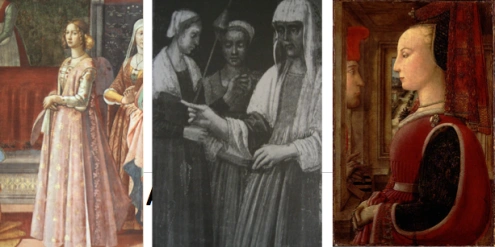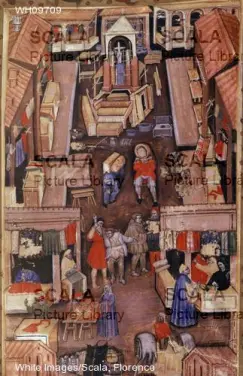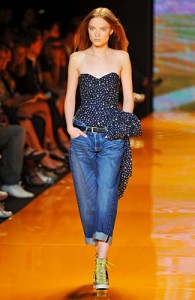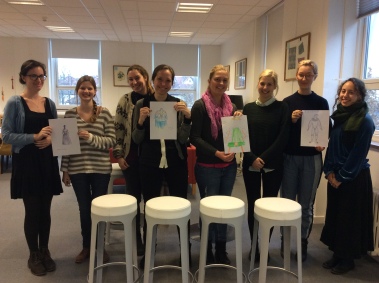As part of my Marie Curie research fellowship at the Centre for Textile Research, I created a 15-week course on early modern dress and fashion for MA- and BA-level students at the University of Copenhagen. The goal of the course, taught in English, was to provide the students not only with new knowledge about historical dress, but also about how historical knowledge is being created in different academic fields. The range of topics were explored from various points of view, including archaeology, art and cultural history, social and economic history and museum conservation. This way, the course aimed at providing the students with an interdisciplinary ‘tool kit’ to study the history dress, textiles and fashion. Here we are, at the start of the course in August.
We started the course by looking at historical representations of dress, discussing to what extent garments might be idealised in visual images. We then moved on to discuss the social and cultural meanings of dress in Early Modern Europe, when I together with my colleague, the cultural historian and curator Mikkel Venborg Pedersen from the National Musuem of Denmark, discussed issues of status, identity and dress both among the elites as well as among popular segments of society.
The social and cultural analysis of dress was followed by an examination of objects themselves. Two lectures, given by archaeologists Charlotte Rimstad and Vivi Lena Andersen, taught the students how real surviving 17th-century dress items, such as shoes, hats and gloves, excavated from Copenhagen moats, can be studied and used to understand early modern dress. Below, is an example of a surviving 17th-century shoe, as well as Vivi Lena with the students, creating a future ‘Shoe-exhibition’ with the students. Charlotte also brought her microscope, allowing the students to learn about the structures of the textiles that the clothing was made of. The historian Camilla Luise Dahl, then, in the next class, read probate inventories with the students, demonstrating how similar items were described in 17th-century archival records from Copenhagen.
The second part of the course focused on new tehcnologies, novel fashion products and fashion dissemination in the early modern period. I had invited the conservator Maj Ringgaard from the National Museum to teach the students how knitting developed in the course of the 15th- and 16th-centuries, and created a great fashion and desire for fine stockings. Below, you can see some visual and material evidence of the early dissemination of this craft; a pair of early hand-knitted socks (Deutches Strumpf Museum) from the late 16th- or early 17th-century, and a depiction of Madonna engaged with knitting, by Bertram of Minden, 1400-10.
Maj had also brought some samples of lace and super fine needles that were required to produce the delicate lace for the students to examine.
Lace and knitted stockings can frequently be seen also in late 16th- and early 17th-century portraits, such as below. Stockings and lace, however, were not the only fashion novelty that spread with an increasing speed in Europe. The 16th-century was a period of a wide circulation of new fashion innovations which, popularised by Spanish and French courts and promoted by flourishing international cloth and clothing trade, introduced new concepts into the traditional, local ways of dressing. Together with my students, we learned and studied how fashions disseminated and international dress fashions spread in Early Modern Europe. Below, the early seventeenth century portraits show two figures dressed in their best, the Earl Richard Sackville, in 1613, and Isabella Clara Eugenia, regent of the Netherlands, 1609.
The third part of the course moved the discussion from the social and cultural spehre to the economic context of dress, taking up issues of production and trade of textiles as well as acquisition and consumption of dress items. Karolina Hutkova, an economic historian from the Warwick University, connected to our CCCC programme here at Copenhagen, taught the student how valuabe silks were produced and traded on a global scale in the early modern period. We then continued with the students to think about the economic value of garments, discussing where and how textiles and garments could be bought, how accessible they were to the people from the lower social orders, how clohting could function as an economic ‘currency’, and what consumption of clothing means. Below is a representation of a 15th-century Bolognese market place, and an exotic, Ottoman cover fragment, made of linen with silk embroidery, 18th Century, today at The Textile Museum, Washington, D.C.
The final part or the course placed the entire content in a theoretical framework, when we focused on the meanings of ‘fashion’ and tried to understand its systems both in the past and the present. We practised making arguments against Veblen’s and Simmel’s trickle-down emulation models, using, for example, the famous case of jeans to create bottom-up models of emulation. Did you know, by the way, that Denim, a mix of linen and cotton fabric originally associated with the working classes and the poor before it became the clothing for all and a fashion item on the catwalk, was invented already in the 17th-century? The painting on the left, originiating from the 17th century and painted by the ‘The Master of the Blue Jeans’, represent a poor boy in a worn out denim jacket!
Making connections between past and present, we also charted some of the interesting historical influences on contemporary fashion, as well as identifed key differences in the use and regulation of dress in the past and present. Here is one stunning example of the use of historical reference in contemporary fashion: the Dolce Gabbana FW13 Dress collection, with references to the Byzantine mosaics from Sicily.
To finish the course, the students then spent a day at the National Museum, thinking about what constituted the museum’s textile and clothing collections, and how they were visually displayed in the exhibition space. The current exhibition on historical fur, called ‘Fur-An issue of Life and Death’, offered a great visual comparison for the students, by contrasting the rather traditional and conventional display of the Renaissance gallery with its glass vitrines and thematic arrangement of the objects, with an exhibition that made a conscious attempt to appeal to emotions as well as senses beyond vision, such as touching and smelling.
My course ended with students’ presentations of their exam topics. I was astonished how well my students were able to use primary sources, from written descriptions of dress and sumptuary laws to real surviving graments and printed and painted images of dress, as well as to apply approaches borrowed from archaeology, art history and economic, social and cultural history for their study. To me, it demonstrated that they had not only acquired new knowledge of early modern dress and it’s key concepts, but that they had really understood how historical knowledge is being created.
At the end of the final class, we decided to have some fun and organise a drawing competition. In pairs, my students were asked to design a fashionable garment in the 16th-century style and ‘sell’ it to the class, explaining how it was fashinoable and why it should win the competition. Here are my wonderful students, with their original 16th-century fashion designs! As a prize, the winning team got to pick some of these beautiful, Italian hand-painted loom weights.
I was given the permission from my students to put the fun drawings online. I wonder if you can you identify the famous historical figures in their designs?
For a more detailed description of the course, see http://kurser.ku.dk/course/hhia04113u/2014-2015
COURSE PROGRAMME
Dress and Fashion in Early Modern Europe (1500-1650), Centre for Textile Researce, Course Organiser and Tutor: Dr. Paula Hohti
Seminars
11.9. 2014 Representations of Historical Dress, Paula Hohti (CTR)
18.9. 2014 Social and Cultural Meanings of Early Modern Dress, Paula Hohti (CTR)
25.9. 2014 Status and Dress in European Elite and Popular Culture, Dr. Mikkel Venborg Pedersen (National Museum)
2.10. 2014 Common People’s Clothing in Early Modern Copenhagen, Charlotte Rimstad (CTR, University of Copenhagen)
- 10. 2014 Innovation in steps. Shoes and shoemaking in Early Modern Europe, Vivi Lena Andersen (University of Copenhagen, Museum of Copenhagen)
23.10. 2014 Stockings and knitted garments: New Textile Techniques and Novel Fashions in Early Modern Denmark, Dr. Maj Ringgaard (National Museum)
30.10. 2014 Fashion Dissemination and International dress fashions in Early Modern Europe, Paula Hohti (CTR)
- 11. 2014 Textiles and trade in the Early Modern Europe, Karolina Hutkova (University of Warwick)
13.11. 2014 Silks and silk thread production in the Early Modern Era, Karolina Hutkova (University of Warwick)
20.11. 2014 Shops and the markets for dress and textiles in Early Modern Scandinavia, Camilla Louise Dahl (CTR, University of Copenhagen)
25.11. 2014 Consumption, clothing and economic meanings of dress, Paula Hohti (CTR)
27.11. 2014 What is fashion? Theoretical approaches to historical dress, Paula Hohti (CTR)
- 12. 2014 Museum visit: Visual and material evidence of dress and textiles, Paula Hohti (CTR)
4.12. 2014 Student presentations and sum up, Paula Hohti (CTR)




























Fascinating course! Would have loved to attend!